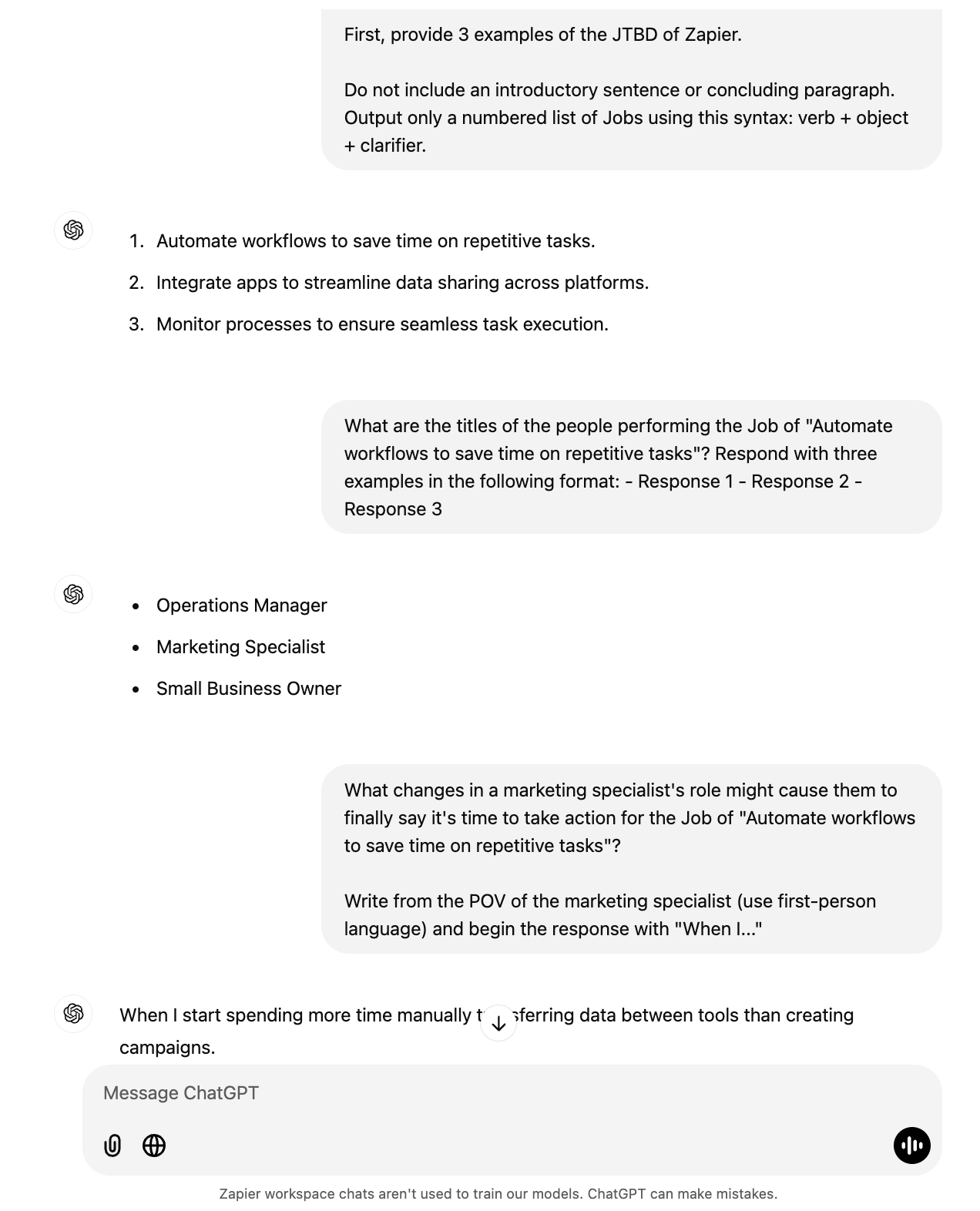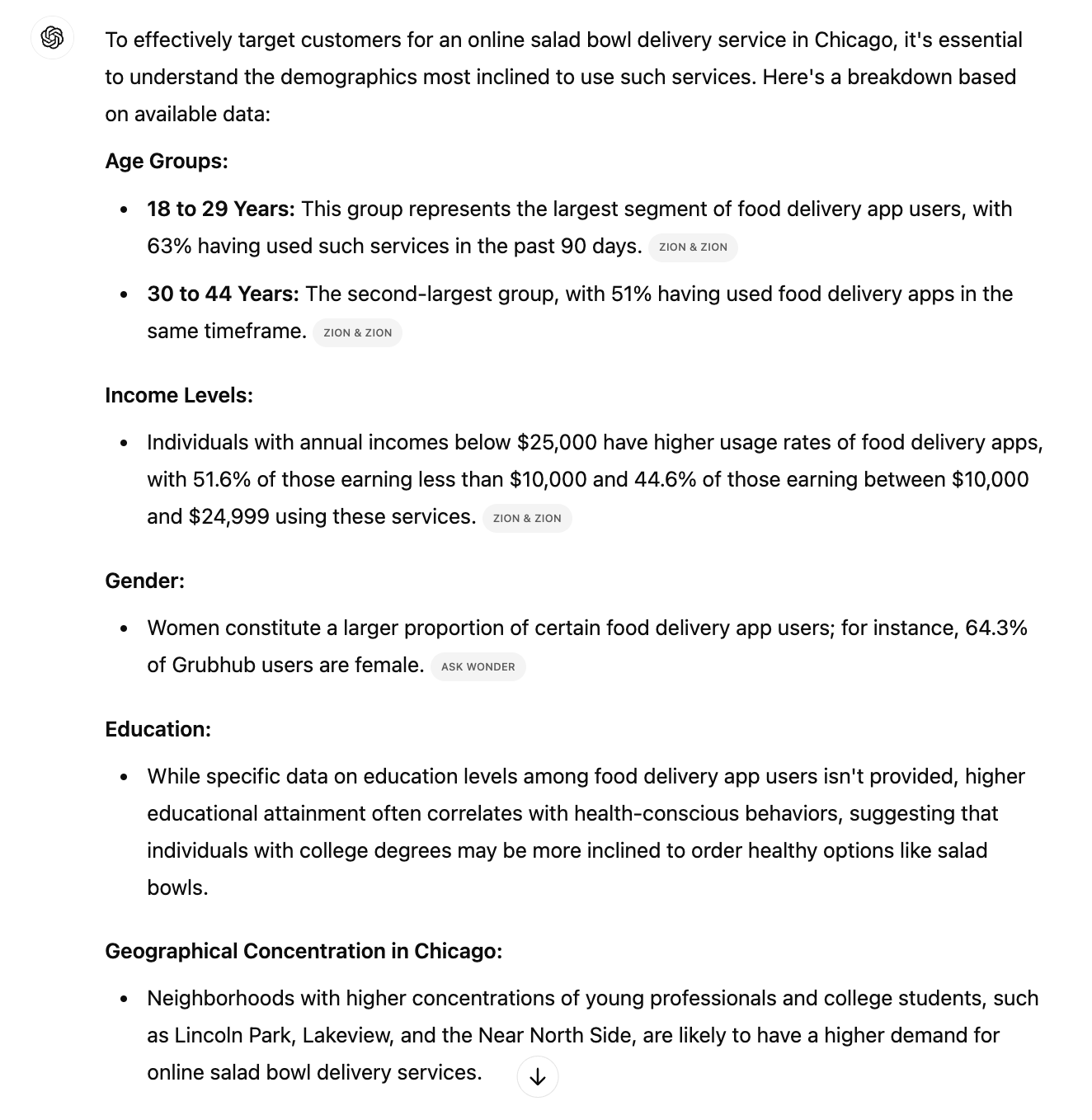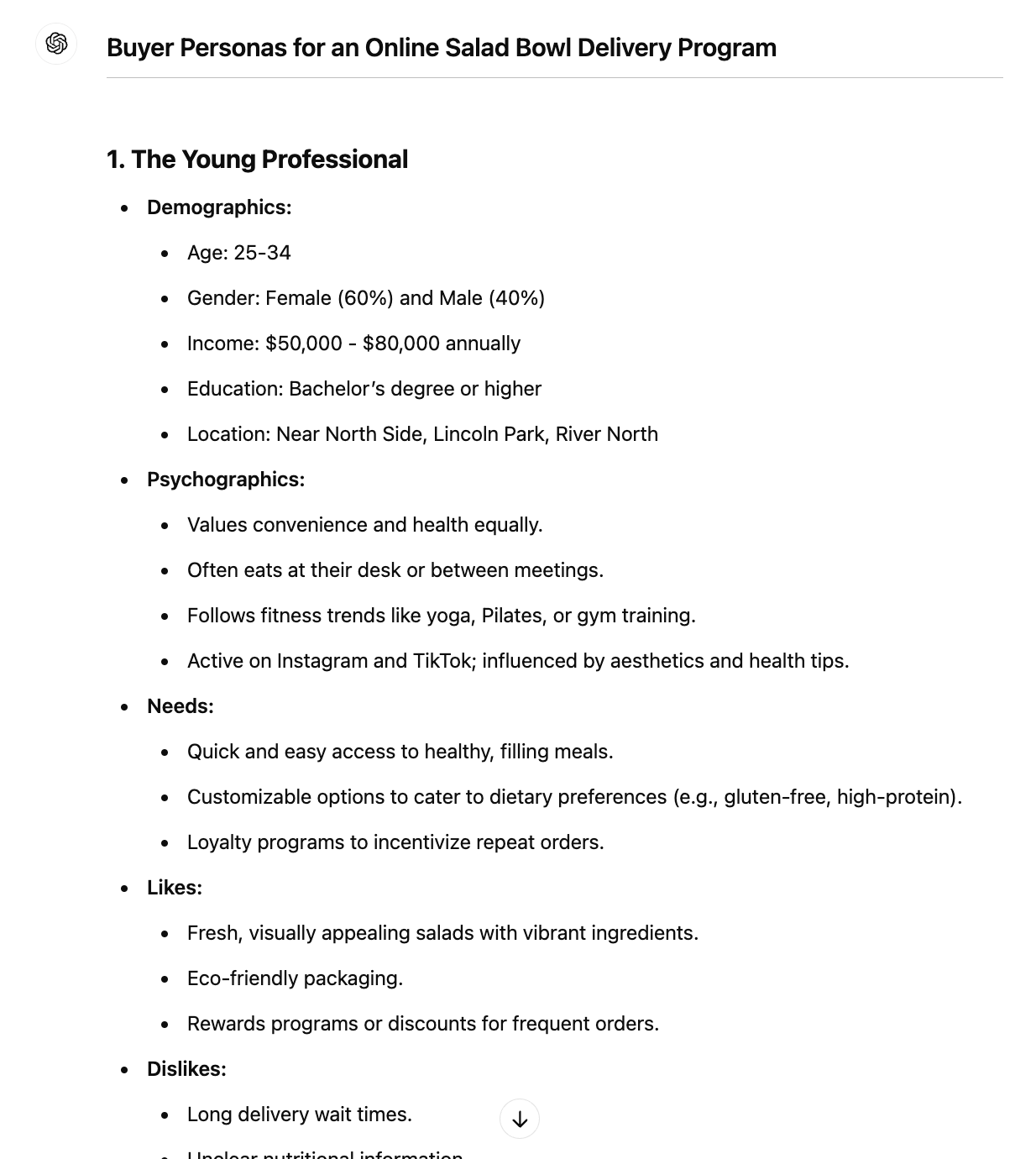Even though ChatGPT’s been on the scene for over two years now, it still feels like we’re just scratching the surface of what’s possible with the help of AI. You can use it to create video scripts, summarize an article, generate AI images—the list goes on.
The more I use ChatGPT in my daily work, the more confident I feel that ChatGPT won’t replace (great) marketers. At least, not anytime soon.
Instead, what I’ve found is that ChatGPT can be a tremendous assistant to marketers—and not just for writing copy. One of my favorite ways to put the AI chatbot to work is by getting it to help me do all the behind-the-scenes foundational work that goes into great marketing. Here’s how to use ChatGPT for market research.
Table of contents:
How to write effective ChatGPT prompts for market research
Before we get into the nitty-gritty of how to use ChatGPT for market research, here are some important prompting tips to keep in mind as you go.
-
Be specific. ChatGPT isn’t a mind reader. The only way you can get quality results is to tell it exactly what you want (and don’t want) it to do. Don’t just ask who the target audience is for your industry. Instead, specify the product or service idea you want to get information about and tell it exactly what you want to know—for example, your target audience’s income level, education, gender, and location.
-
Role-play. Tell ChatGPT who it is before starting your market research queries. For example, digital marketing consultant Natalia Brzezinska draws inspiration from marketing leaders like Seth Godin and Brian Dean. When she wants responses that align with the distinctive strategies of these leaders, she tells ChatGPT to act like them. And it doesn’t have to be a real person: you might, for example, ask ChatGPT to act as an experienced market researcher or research assistant. This gives the chatbot more context, which results in better outputs.
-
Keep following up. Let each prompt build upon the one before it. Take a look at how product marketer Brian Rhea does this in the image below. He uses ChatGPT to “expedite the ‘fuzzy front-end’ of customer research,” and according to Brian, he’s able to conduct preliminary jobs-to-be-done (JTBD) research—a job that typically takes weeks to complete—in mere minutes. Notice how he keeps specifying what he wants and doesn’t want—for example, “no introductory sentence or concluding paragraph,” “respond in the following format: [describe format],” “begin the response with ‘When I…'”), building on what came before.

-
Don’t rely on it alone. It’s best to use ChatGPT at the very early stages of market research when you’re still playing around with an idea. Since ChatGPT doesn’t take long to generate responses, you can quickly figure out if the idea you have will fly with your target audience. Once you’ve determined that it will, it’s time to dig in with other resources, like customer reviews, social listening, and survey data.
Prompting ChatGPT with the same background information and instructions over and over again? Use ChatGPT’s custom instructions (available to all users) or create a custom-made chatbot (available on paid plans) instead. This way, you can tell the chatbot what you want it to know, along with any other requirements, and it’ll automatically consider these every time it generates a response.
4 ChatGPT prompts for market research
ChatGPT’s ability to understand (and replicate) natural language can help you get a better understanding of your customers’ motivations and sentiments—both of which inform market research. In talking to marketers who use ChatGPT for market research, I learned that they’ve been using it for all sorts of purposes, but these are the four that popped up the most:
-
Gathering and presenting publicly available data
-
Developing buyer personas
-
Identifying competitors
-
Getting suggestions for how to fill in existing market gaps
I’m going to use a fictional scenario to demonstrate all this and offer some suggestions for prompts.
Imagine you own a vegan restaurant in Chicago. You want to start an online delivery program where your customers can order healthy salad bowls via an app and have the food delivered to their doorstep.
Let’s dive in.
1. Gather and present publicly available data
The first step in market research is to gather data on your demographic. There are many ways to do this, including market research surveys and customer interviews, but ChatGPT can speed up the process using publicly available information.
Prompt: I want to start an online delivery program where my customers can order salad bowls via an online app and have the food delivered to their homes in Chicago. Act as a market researcher and give me information on the demographics of people most likely to order salads in Chicago—including age groups, income, education, gender, and specific location.

In a matter of seconds, ChatGPT determined that the target audience is made up of young and middle-aged individuals who earn well, are health-conscious, have a good education, and live in affluent areas. It even offers suggestions for which neighborhoods have higher concentrations of your ideal customers. This gives you an idea of the kind of people to focus your marketing efforts on.
2. Develop buyer personas
Let’s build on that answer and ask ChatGPT to develop buyer personas for your business.
Prompt: Create detailed buyer personas for this online delivery program that delivers salad bowls to customers? Provide demographic info, psychographic info, needs, likes, and dislikes.
ChatGPT spit out multiple buyer personas, including The Young Professional (shown below) and The Health-conscious Parent, complete with insights into their general behaviors and what they want—two things that are crucial in understanding your target market.

The personas ChatGPT outputs may not be perfect, but they give you an idea of the spectrum your customers might be on.
3. Identify competitors
The next step is to identify competitors in your industry.
Prompt: Make a table of the top 5 brands in the food delivery space, their website URLs, Instagram handles, and some important data about each of them.

This table shows that if you create your own online delivery program, you’d be competing against some of the largest food delivery brands in the world. Now, you’re faced with two choices: create your own online delivery app and have only your loyal customers use it, or partner with one (or more) of these food delivery brands to bring your salad bowls to a broader audience.
3. Get suggestions for how to fill in market gaps
Finally, it’s time to check if there are any market opportunities for differentiation. After all, you want your online delivery program to have something unique about it.
Prompt: Are there any market opportunities or unique selling propositions (USPs) that current food delivery brands, like DoorDash, Uber Eats, and Postmates, don’t take advantage of?

Just like that—you have a bunch of strategies to help distinguish your online delivery program from similar brands in the industry.
Get market research insights with ChatGPT
What I did above is just scratching the surface—imagine if I had continued to dig deeper with each answer.
But remember: you should always support ChatGPT’s answers with actual data you gather from speaking to your audience. Not only because it’ll give you a more nuanced understanding of your market, but also because ChatGPT hallucinates: it can give you information that might sound reasonable but is actually made up.
Automate ChatGPT
If you’re using ChatGPT for market research, you’re probably using it in other parts of your workflow too. As it becomes more deeply involved in your work, you can connect it to Zapier to access ChatGPT from all the other apps you use at work and automate your entire marketing workflow. Learn more about how to automate ChatGPT, or get started with one of these premade workflows.
Zapier is the leader in workflow automation—integrating with thousands of apps from partners like Google, Salesforce, and Microsoft. Use interfaces, data tables, and logic to build secure, automated systems for your business-critical workflows across your organization’s technology stack. Learn more.
Related reading:
This article was originally published in May 2023. The most recent update, with contributions from Jessica Lau, was published in December 2024.